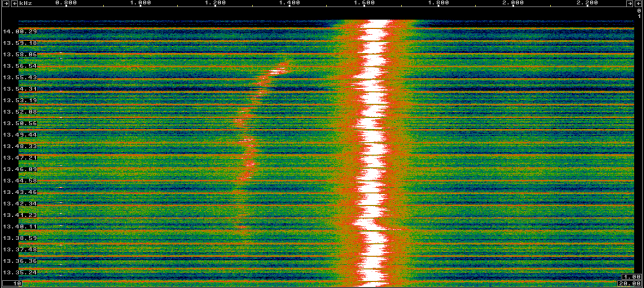I’ve started to experiment with the RS92-SGP radiosonde that I recovered some days ago. The radiosonde has a M95256-W 32KB SPI EEPROM where all the code and settings are stored, since the onboard CPU/DSP doesn’t have any flash memory. Several parts of the firmware, including some of the settings have being reverse engineered. Thus, it is useful to interface the EEPROM to a microcontroller to rewrite some settings, perhaps to change the transmit frequency or the radiosonde’s ID (the serial number which is also printed on the radisonde’s box).
Posts
Recovering an RS92-SGP radiosonde
A few days ago, I talked about the radiosondes that are launched every 12 hours from Madrid-Barajas Airport. Yesterday, I went with my mother on a trip to try to recover the radiosonde that was launched at 11:00UTC. This radiosonde managed to ascend to 31000m before bursting. This is quite high for a radiosonde of this kind, as they usually burst between 24000 and 28000m.
We left home at 13:00UTC, so the radiosonde was quite far from us by that time. The last telemetry we managed to decode was when the radiosonde was 3800m high and on its way down. It was flying over Sacedón, in Guadalajara, and slowly drifting eastwards along the road. We were still on our way to Guadalajara, more than 40km away.
Linear 12V 5A power supply
I wanted to build something easy and useful this summer, so I have gone with a 12V (also adjustable to 13.8V) 5A linear power supply. The design is based on the 12V 15A power supply by Ed WA1TWX that appears in the 2015 ARRL Handbook. The main difference is that I’m using only one pass transistor instead of three. Here I describe my design.
Receiving the Vaisala RS92-SGP radiosonde launched from Madrid-Barajas
Each day, at 01:00UTC and 11:00UTC a Vaisala RS92-SGP radiosonde is launched from Madrid-Barajas airport. This is a small electronics package tied to a helium balloon that ascends up to between 24 and 28km high before bursting and descending on parachute. It is designed to measure atmospheric parameters on its way up. It includes temperature, pressure and humidity sensors, as well as a GPS receiver. The launch on Wednesdays at 11:00UTC also includes a plug-in ozone sensor (which is a much larger and more expensive package). The data is transmitted at 403MHz using Manchester-encoded 4800bps GMSK and protected using Reed-Solomon. You can find more information about the RS92-SGP model in its technical datasheet and about the launches at Madrid-Barajas and other launches in Spain in the Spanish AIP Section 5.3 (other activities of a dangerous nature). Also, there is somebody who feeds the radiosonde data into the APRS network using SM2APRS, so you can track the launches by following OKER-11 on aprs.fi.
Usually, the Sondemonitor software is used to receive and plot the parameters measured by the radiosonde and track the GPS data. Of course, this program is very nice and complete, but it is shareware, costs 25€ and runs only in Windows. I wanted to try if it is possible to track the GPS data in Linux using free software.
Concurso Nacional V-UHF
Today I’ve hiked up with my father to Siete Picos, SOTA summit EA1/SG-005 (2138m), to participate in this month’s national V-UHF contest. We arrived and set up around 07:30UTC and worked until 11:30UTC, where activity became low, as most possible contacts were already done and people started to leave in order to prepare lunch. The equipment was a Yaesu FT-817ND and an Arrow yagi antenna (3 elements in 144MHz and 7 elements in 432MHz).
Below is the map of stations worked. My position is in red, stations worked both in 144MHz and 432MHz are in green and stations worked only in 144MHz are in blue. The black station is the odd one that I could only work in 432MHz. This can happen if you catch them first in 432MHz, then a big mess with several stations arises and you’re unable to tell them to change to 144MHz to make the contact and decide that you’ll catch them in 144MHz later, but you don’t manage to find them later.
Improving phase noise performance of the DF9NP 27MHz PLL
In some of the latest posts, I’ve being talking about the phase noise performance of 10GHz receivers, and in particular, of 27MHz references for Ku-band LNBFs (1, 2, 3, 4). Indeed, this started when I checked the performance of my new 10MHz GPSDO and 27MHz PLL by DF9NP and I wasn’t too happy with the phase noise.
After working with Dieter DF9NP in investigating this problem and performing several tests, Dieter found that the problem was likely in the loop bandwidth of the 27MHz PLL. The loop filter bandwidth is 50kHz. He proposed the following component modifications to change the bandwidth to 300Hz.
Update 2018-10-21: Dieter tells me that this problem has been solved in the new units he is selling, so the performance of the new units should be good.
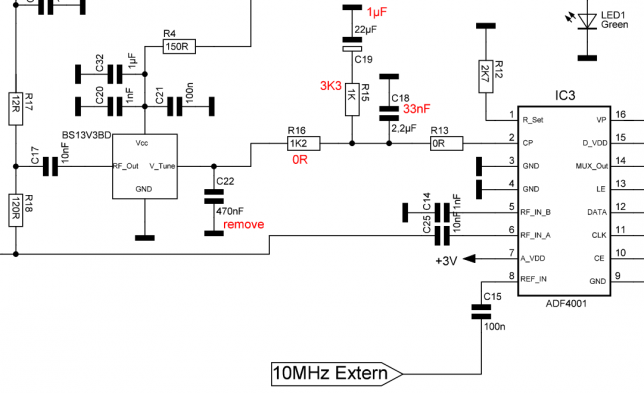
After I performed the modifications, I was quite surprised and happy with the results. As always, I’ve used the beacon of BADR-5 at 11966.2MHz to test the phase noise performance. Linrad’s AFC is in use. The result is below. As you can see, it is as good as the best references that I had tested before.
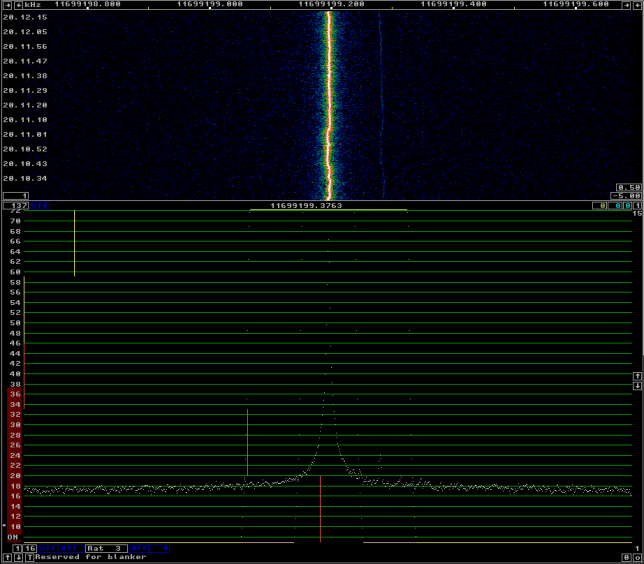
For comparison, this was the performance before the modification. The difference is huge. Many thanks to Dieter for his effort and to Luis EA5DOM, who also participated in the discussion and gave some good advice.
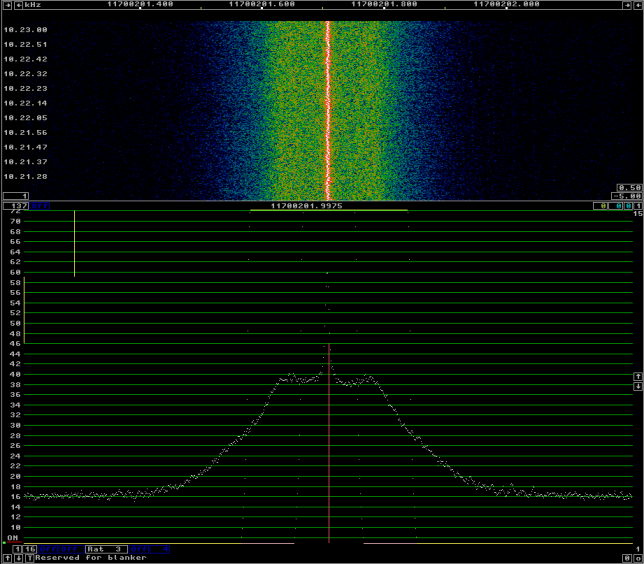
Arduino aquarium controller
Just a quick note that I’ve finally put the page for my Arduino aquarium controller. This is a project that I built several years ago to control a small aquarium at home. I built it with through-hole parts on a home etched single-side PCB. Now I’ve redesigned the project to use SMD parts and double-sided PCB.
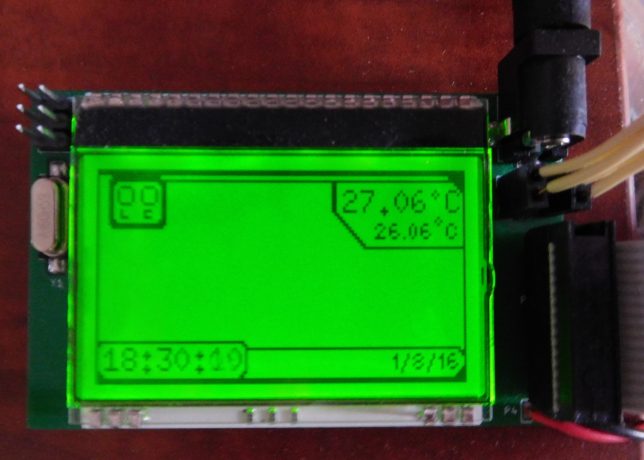
Update on phase noise of 27MHz references
This is a follow up to a previous post where I investigated the phase noise of 27MHz references to be used for a 10GHz receiver. Dieter DF9NP has being kind enough to send me a 10MHz 0.25ppm TCXO to do some more tests.
I’ve connected the 10MHz TCXO to the DF9NP 27MHz PLL and used it to receive the beacon of BADR-5, as I did in the previous post. The phase noise of the 10MHz TCXO + 27MHz PLL can be seen in the following figure.

For comparison, see below the phase noise with the DF9NP 10MHz GPSDO and 27MHz PLL. There is not much difference between both. This seems to indicate that the culprit of the phase noise is the 27MHz PLL, as the 10MHz TCXO should be quite clean.

Phase noise of a Baofeng UV-5R 10GHz signal
Several of the Baofeng chinese handheld radios generate a weak 10GHz signal while in receive mode. Thus, they are a popular cheap and quick 10GHz signal source for tests. To generate a 10GHz signal, you have to tune the Baofeng to the 70cm band (for instance, 432MHz). The radio will generate a weak 24th harmonic while in receive mode. If you want a steady carrier, you have to set the squelch to zero. Otherwise you will just get beeps as the radio wakes up periodically to check for a signal. Lately, I’ve being investigating phase noise and reciprocal mixing of 10GHz receiver systems. A natural question is how good is the phase noise of a Baofeng used as a 10GHz signal source and whether it can be used to check if the phase noise performance of a receiver is acceptable. It turns out that it is not so noisy as one may first think.
Ship reflection on ED5YAE 10GHz beacon
In my previous post, I mentioned the possibility of receiving 10GHz beacons reflecting off ships in the Mediterranean sea through the Paella Team WebSDR, in Alicante. Luis EA5DOM tells me that these reflections happen often. However, I didn’t get any in the time I was doing the recordings for the previous post.
After making much longer recordings, I have seen a couple of reflections. I would say that a dozen or so happen every day. However, they last for quite long. Here you can see a reflection lasting for almost 20 minutes. The Doppler shift ranges between -300Hz and -200Hz. At its strongest moment, the reflection is only 10dB weaker than the beacon.
